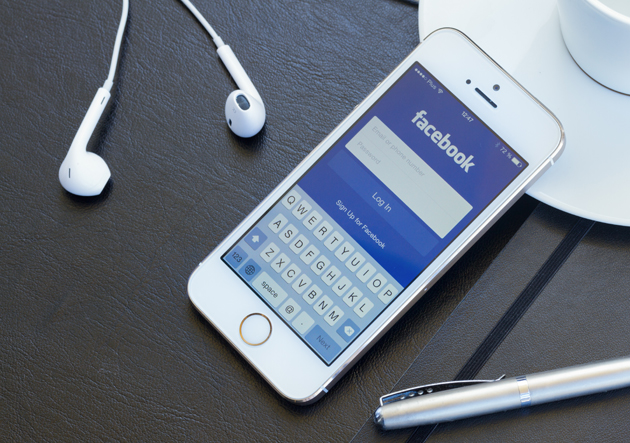Facebook knows that password leaks endanger its users, even if it's another website that's been hacked, because people tend to reuse their log-in credentials (remember that recent Dropbox issue?).
That's why it has developed a process that actively monitors news of
huge security breaches and scans "paste" sites like pastebin, which
hackers typically use to distribute username and password dumps. Upon
finding a collection of email addresses and passwords, the system uses
an automated process to check them against the social network's user
database. Facebook says that doesn't mean it has copies of people's
passwords in plain text, though: it encrypts or hashes
stolen passwords first before comparing them to similarly encrypted
log-in details. In the event that the system does spot an exact log-in
combination that's also used on Facebook, it walks the user through
changing his password the next time he logs in.
Showing posts with label Facebook. Show all posts
Showing posts with label Facebook. Show all posts
Friday, 17 October 2014
Saturday, 30 August 2014
Sound Off! Are you sticking with Facebook Messenger?
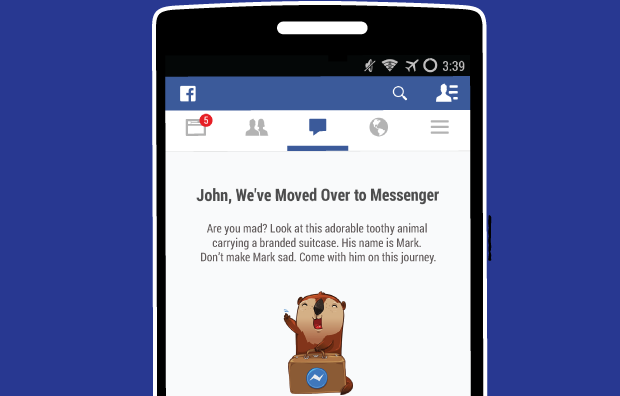
Facebook's Messenger app isn't new -- it's been around since 2011. It was up to users to decide if they wanted a separate app or if they liked exchanging messages inside the regular Facebook app. Now if users tap the message icon on Facebook, a message appears telling them to move over to Messenger. It's no longer an option; it's a requirement Facebook put in place to deliver "the best mobile messaging experience possible."
Saturday, 12 April 2014
Facebook Pulls Chat Feature From Phone App
Mobile users will be forced to download a separate app if they want to continue to communicate with their Facebook friends.
Facebook has started to remove the chat feature from its main app - meaning users will have to download a separate standalone app if they want to communicate with friends.
The main Facebook application has always had a messaging tab, but from today users in several European countries - including the UK - are being notified the functionality will be pulled.
If they want to continue to chat to their friends, they will have to download the Facebook Messenger app, which like the main app is free.

A Facebook spokesman said: "Today we are starting to notify people that messages are moving out of the Facebook app and over to the Messenger app.
"To continue sending messages on mobile, people will need to install the Messenger app."
Facebook founder Mark Zuckerberg warned of the change in a public question and answer session last November.
In it, he said: "The other thing that we're doing with Messenger is making it so once you have the standalone Messenger app, we are actually taking messaging out of the main Facebook app.

"And the reason why we're doing that is we found that having it as a second-class thing inside the Facebook app makes it so there's more friction to replying to messages, so we would rather have people using a more focused experience for that."
Messaging is one of the big battlegrounds for technology firms, with apps such as Kik, KakaoTalk and WeChat picking up millions of users.
Facebook recently bought free messaging app WhatsApp for $19bn (£11.3bn).
The Facebook Messenger app has a 3.5 star user rating on the Apple App Store, compared to the main app's 2.5 rating.
Friday, 11 April 2014
Facebook’s Feed Now Punishes Pages That Ask For Likes Or Share Reruns
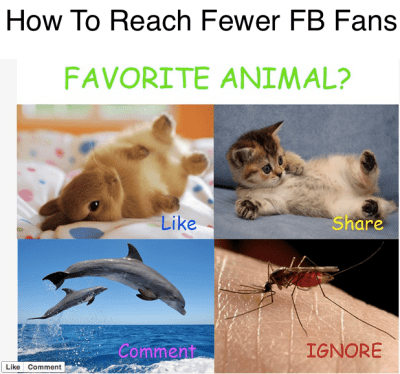
You’re not clever enough to fool Facebook. Asking users to “Like this post!”, sharing the same link or photo over and over, or bait-and-switching people with links to ad-filled sites will now get your Page’s reach in News Feed destroyed, the company said today. Share unique, interesting content and you’ll be fine.
Last week I wrote a deep guide to why Facebook’s Page reach is naturally declining and how News Feed works. The tl;dr is that there are more and more Pages and friends competing for the finite amount of time people spend reading the feed. Increasing competition plus limited attention equals decreasing reach.
The way to keep your own reach up is to share posts that are widely Liked, commented on, shared, and clicked. Those signals tell Facebook’s News Feed algorithm that your posts are worth showing to more people. Here’s a simplified equation for how the feed picks what to show. It features the top five factors Facebook looks at, but there are a hundred thousand others.
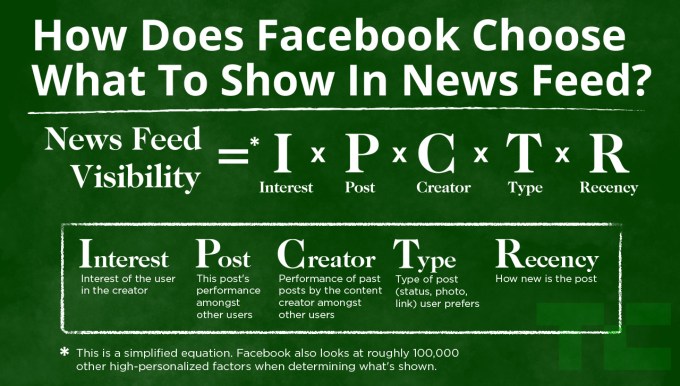
Today’s announcement, part of Facebook’s push to increase transparency about how News Feed works, lays out factors that will get your Page quarantined. Many of these have likely been in play for a while, and Facebook started punishing usage of image memes last year, but now these transgressions could with heftier penalties. Here are the rules:
- Don’t explicitly ask users to Like, comment on, or share your posts, either in text or photos. Facebook will detect this and reduce your reach
- Don’t share the same content repeatedly. Yes, it might be important to you, but your fans don’t want to see it in their feeds multiple times. If you need to share the same link, do it with a different description or photo each time.
- Don’t say a link leads to one thing when it really goes somewhere else. AKA don’t say “check out our photo gallery” and instead link them to an ecommerce purchase page or site with nothing but ads. Facebook will likely see that users start browsing their feed again a half-second after clicking your link because what was on the other side was a scam, and beat you up for it.
Sunday, 6 April 2014
Facebook to buy virtual reality firm Oculus VR for $2 billion

Just a month back, we reported about the acquisition of WhatsApp by Facebook for the staggering price tag of $19 billion. The dust has hardly settled, but it has emerged that the social network giant this week has acquired a company called Oculus VR for $2 billion.
As expected, the deal has been met with a wave of incredulity that Mark Zuckerberg would sign off on it. After all, Oculus is a two year old company that has no revenue and no product yet in the market. So what did Facebook see in it? On its part, WhatsApp has real users and market share, while all Oculus has to show for at the moment is a prototype virtual-reality headset that is still far from shipping.
In a post on his Facebook page, Zuckerberg mentioned that he saw the future when trying on the headset and decided to invest on it. Oculus has big plans in immersive gaming industry and Facebook is hoping to accelerate the growth, he wrote, with plans to grow further into many other experiences in digital life.
According to Zuckerberg, uses include “enjoying a court side seat at a game, studying in a classroom of students and teachers all over the world or consulting with a doctor face-to-face — just by putting on goggles in your home.”
Not everyone is impressed by the acquisition though. Indeed, many gamers and developers have expressed their concern that Oculus under Facebook will no longer be able to realize the gaming possibilities that were promised, reported the Washington Post. Developers were also quoted as saying that forcibly linking the Oculus Rift VR headset back to Facebook would eventually cause great games to be stuck in an untenable position.
Tuesday, 1 April 2014
What Zuckerberg Sees in Oculus Rift
Facebook acquired Oculus Rift because it believes virtual reality could be the next big thing after mobile.
Facebook moved quickly to acquire Oculus VR—creator of the forthcoming Oculus Rift virtual reality headset—for approximately $2 billion. Discussions between the two companies opened less than two weeks ago, according to Oculus VR’s CEO Brendan Irebe. “We locked ourselves in the Facebook HQ and just got the deal done really fast,” Irebe told theWall Street Journal. “We don’t want to disrupt the team and go through months of negotiations.”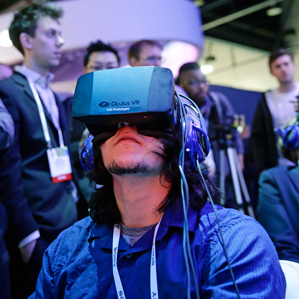

Facebook’s founder and CEO Mark Zuckerberg reportedly instigated the deal. “Strategically we want to start building the next major computing platform that will come after mobile,” he said on a conference call on Tuesday night. Zuckerberg sees the acquisition as part of Facebook’s mission to build the so-called knowledge economy. “There are not many things that are candidates to be the next major computing platform,” he said. “[This acquisition is a] long-term bet on the future of computing.”
Zuckerberg described his first time using the VR headset as revelatory: “When you put on the goggles, it’s different from anything I have ever experienced in my life,” he said.
The headset, designed by 21-year-old Palmer Luckey, has been available as a developer kit since March 2013. So far it’s primarily been used for video games (see “Can Oculus Rift Turn Virtual Wonder into Commercial Reality?”). John Carmack, co-creator of the seminal 3-D video game Doom, joined Oculus VR in August; many enthusiasts and independent game makers have already released games and demos for the hardware. This has happened even though the company hasn’t announced a launch date for a commercial version of the hardware. At this point the device isn’t expected to be released any earlier than the end of this year.
Facebook views the technology as more than a peripheral for video games. “Immersive virtual and augmented reality will become a part of people’s everyday life,” Zuckerberg said. “History suggests there will be more platforms to come, and whoever builds and defines these,” he said, will shape the future and reap the benefits.
Asked on the investor call why the time is right for mass-market virtual reality, Zuckerberg cited the low cost of the necessary components. “One of the things driving this is that people can reuse components mass-produced for phones that can render a world quickly enough to not make a person feel motion sickness,” he said. “You need to render everything in a virtual world within 15 milliseconds, otherwise it’s too jarring and doesn’t feel real. For the first time, we are able to do that.”
The Oculus VR team posted a blog on the company’s website last night, acknowledging that the partnership with Facebook might seem odd at first glance: “But when you consider it more carefully, we’re culturally aligned with a focus on innovating and hiring the best and brightest; we believe communication drives new platforms; we want to contribute to a more open, connected world; and we both see virtual reality as the next step.”
Not everybody shares the optimism about Facebook’s new acquisition. Among the deal’s critics are some who backed the original Oculus VR Kickstarter campaign in August 2012. Markus Persson, the outspoken creator of Minecraft, wrote on his blog “I did not chip in ten grand to seed a first investment round to build value for a Facebook acquisition.”
Persson also tweeted to his 1.5 million followers that he had been in talks with Oculus concerning a VR version of Minecraft, but “I just canceled that deal. Facebook creeps me out.” In his blog post he complained that Facebook’s focus on social interactions rather than video games may harm the Oculus vision. “Facebook is not a company of grass-roots tech enthusiasts,” he wrote. “Facebook is not a game tech company. Facebook has a history of caring about building user numbers, and nothing but building user numbers. People have made games for Facebook platforms before, and while it worked great for a while, they were stuck in a very unfortunate position when Facebook eventually changed the platform to better fit the social experience.”
Another critic is Jaron Lanier, who founded the first VR company, VPL Research, in 1983. Lanier warned that the acquisition could have a stultifying effect: “I have seen a lot of cases where big ticket acquisitions seem to actually slow innovative startups down,” he said in an e-mail to MIT Technology Review. “Whether the combination of Oculus and Facebook will yield more creativity or creepiness will be determined by whether the locus of control stays with individuals or drifts to big remote computers controlled by others.”
Others from within the video game industry see good things about the deal. Andy Payne, the chairman of the Association for U.K. Interactive Entertainment and of Mastertronic, one of the U.K.’s longest-running video game publishers, said: “This could be an amazing deal if Oculus is allowed to press on, but more quickly. Facebook’s mass-market power will move VR into the mainstream. They have bought a vision of the future. And they have also bought future relevance.”
Even Lanier, who works at Microsoft and is rumored to be developing a parallel product for Xbox One, restated his belief in the technology: “VR can be tremendously fun and beautiful.”
Saturday, 29 March 2014
Facebook: A visual history...
Sit down. Strap on your virtual reality headset. Now you're navigating the crowd of your online friends, sparking face-to-face conversations in a virtual worldpeppered with branded "experiences." Gone are the days of clicking through images of your friends' far-flung vacations; now you walk the beaches of Fiji, sipping tropical drinks, watching and hearing the waves crash like you're there -- because you are.
At its start, it was a college-only collection of user profiles and groups based on shared interests.
In the not-too-distant future, our online interactions could feel a lot more real. That's why Facebook has invested $2 billion in Oculus VR, anyway. It's attempting to own the next big shift in computing and communication. Acquiring a startup with popularity on the upswing is a move that we've seen before from Mark Zuckerberg, but there's more to his company's sustained growth. Back in 2004, The Facebook looked more like a database than a key player in social networks. At its start, it was a college-only collection of user profiles and groups based on shared interests. Students on college campuses around the US were logging on and spilling all of their deets on a bare-bones interface. However, the rather sterile aesthetics wouldn't last long.
Other social sites predated Zuckerberg's project, but none of them kept pace with the mass sharing and design tweaks that have contributed to Facebook's longevity. The company has even taken to retooling key pieces of the interface several times in a span of a few months to keep content consumption on the up and up. The old adage is "form follows function," and the folks in Menlo Park are clearly familiar with the sentiment.
While Facebook is busy figuring out what the future of social networking will look like, let's take a look back at where it's been.
SOCIAL NETWORKS TAKE ROOT
Friendster wasn't always a social gaming site, and though it may not be the first, it was a pioneer of widespread adoption for virtual interaction. As you may remember, that particular social hub debuted back in 2002 and drew over 100 million users through 2011. Focused on user info and a circle of internet acquaintances (ahem, Google+), the hub never evolved much beyond the profile-based system that enabled contact management and sharing between users and their networks. After years of declining traffic in the states, Friendster relaunched in 2011 with a gaming focus and most of its traffic shifted to Asia.
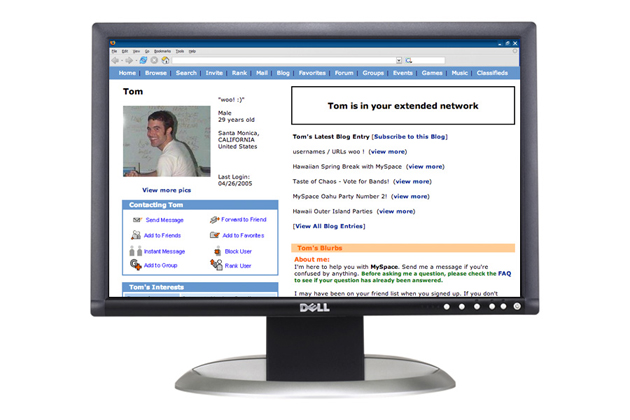
Before The Facebook arrived, Myspace was the largest social network on the web. It launched in 2003 and morphed into its then-popular social format while amassing millions of users through 2008. In fact, it has been reported that in 2005, Myspace considered buying Zuckerberg's site for $75 million before passing. Moving through a News Corp. acquisition and other key transitions, Myspace stuck to portal-like functionality that relied heavily on music and other entertainment content. In the meantime, emerging social media darlings like Facebook and Twitter sought to develop and roll out new features on the regular. The new kids on the block paid attention to how people used their sites and services, and made sure to keep ease of use at the forefront of any new functionality or design tweaks. It turned out to be the difference in continued growth.
Myspace implemented design updates along the way, but they were largely aesthetic and lacked the introduction of key features needed to foster a loyal long-term user base. The site relaunched last year after a "community-led" redesign process, but it still has a heavy focus on entertainment -- music in particular. There's an artist-curated My Radio feature and mobile apps that serve up easy access to content, however it appears to be too little too late. The choice to keep the profile-centric setup, and its inability to roll out new features quickly, doomed the site.
THE BEGINNING
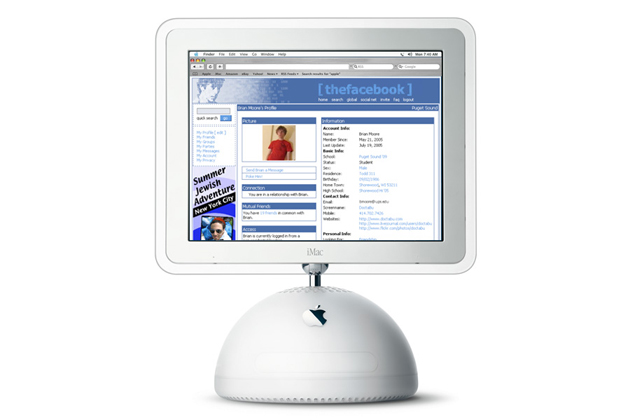
In the early days, user profiles on Facebook were all about information. As you can see from the above image of a profile page in 2005, a person's favorites, relationship status, birthdate, interests and, most importantly, contact info were compiled into a single, easily accessible page. It was very much a digital Rolodex, and not too far removed from the likes of Friendster and Myspace. Each piece of data that you entered placed you in a group based on that criterion. Holmes High School Class of '02? Your classmates are there. Graduating from that college you're attending in '06? Your fellow graduates are a click away. Heck, you could even harness the power of cult classics like Donnie Darko when searching for fellow enthusiasts. Of course, the Wall was there for leaving notes, too.
NEWS FEED
Once you open up a service to anyone, you've got to keep new features coming on the regular in order to keep users coming back. The masses likely wouldn't have sustained interest in an online directory, and Facebook wasted no time making the necessary tweaks. It added Photos in 2005 while it was still a campus exclusive. The UI for snapshots has been retooled regularly since then, but the ability to share galleries from Spring Break and other exploits has been available from the start. What began as a means to share images with friends online turned into a life-logging activity as time went on.
Nearly a year after galleries of summer vacations and ski trips found a home on Facebook, it introduced a new feature that would become a key piece of its functionality: News Feed. No more clicking through to a user's profile page to get the latest on their activities. That info was now arranged in chronological order when you logged in. Status updates, photo posts and more were compiled in a scrolling list of the latest from your friends. Info from Pages arrived on the feed in 2007 and the all-important Like button for each bit of content landed in 2009.
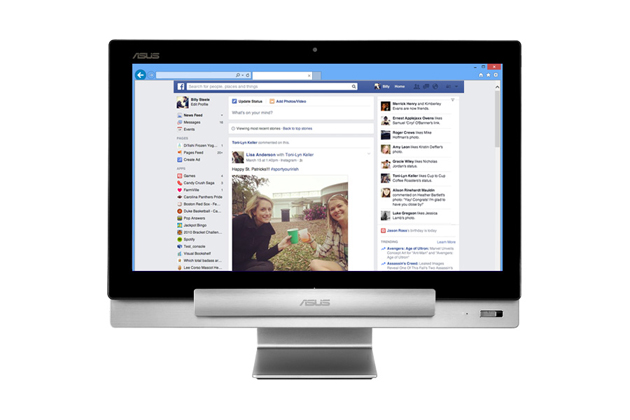
Once the News Feed became the epicenter of activity on Facebook, design tweaksbegan to roll out as needed. Just weeks ago, it announced that the next versionwas on its way, citing the never-ending quest to make its offerings easier to use while keeping them tidy. This marks the third design overhaul of the site's hub in about year, further confirming Facebook's modus operandi: Keep what's important easily accessible.
GOING MOBILE
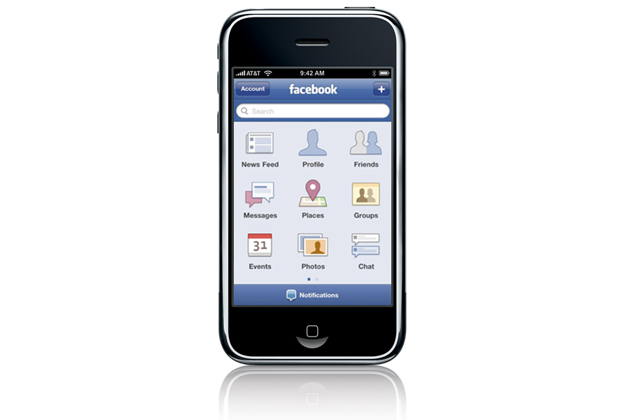
Over the past couple of years, Facebook has aggressively focused on mobile engagement, but its first foray into mobile actually began back in the spring of 2006. The first offering, a mobile-friendly site, dubbed Facebook for Mobile, launched then and the first native app outfitting the OG iPhone hit iOS in the summer of 2008. Even in the early days of smartphones, the social network was already facilitating sharing on the go. Android, Windows Phone and other operating systems would get their own native apps upon their arrival, with the expected regular updates to add new features and refresh the UI.
After rounds of rumblings spanning several months, the long-rumored "Facebook Phone" broke from cover in April 2013. Sure, other devices had dedicated buttons for quick and easy sharing, but the HTC First offered a skinned Android OS, calledHome, built entirely around the social network. The company labeled Home as something between a full-fledged OS and the average app. In terms of aesthetics, the offering took on Facebook's clean look with photos at the forefront. Cover Feed gave a rundown of the current happenings and Chat Heads offered pop-up style text updates from Messenger convos.
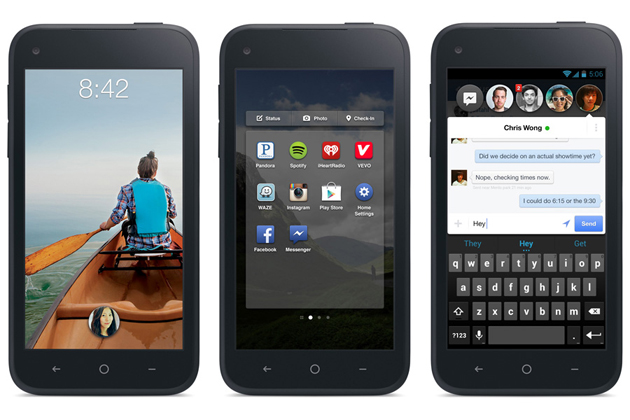
While other Android apps were accessible with Home, it wasn't until October of that year that deeper integration launched, bringing more of a user's content to lock and home screens. Despite opening up Home to a smattering of other devices in addition to the First, both the handset and the non-OS have yet to see widespread adoption and are viewed by many to have been a bust.
FACEBOOK ADS
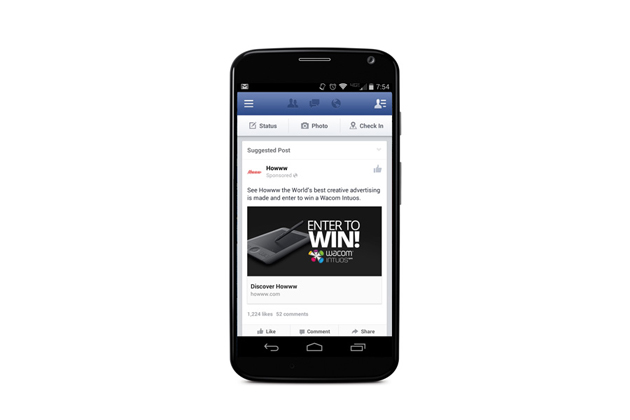
We've all seen them since they became embedded in the News Feed, but ads on Facebook actually started rolling out in 2006. They appeared in the form of banners then, with the formal rollout of the company's successful platform being officially announced in late 2007. Focusing on targeted ads based on user activity, Facebook has placed these sponsored promotions on the right-hand sidebar and within the main activity feed for the site on the web and mobile devices, draped in the appearance of any other shared item from an internet pal. The long arm of Facebook's ad strategy has also extended to once-ad free Instagram, and while it's promised to keep WhatsApp a commercial free zone, Zuckerberg's hinted at anad-filled future for Oculus.
THE CONSTANT REDESIGN
Although Myspace looped back with a massive redesign last year, the steep decline that led to its mere $35 million sale has been widely attributed to sticking to its profile-centric setup. Not until the site had all but left the minds of former users did it reach out to entertain feedback. Facebook, on the other hand, has been keen to watch how its now 1 billion users share and consume content, adjusting the UI and adding new features to keep what's of individual importance on top and easily accessible. This strategy doesn't just apply to the web; it's carried out across the desktop, mobile and supplementary apps like Messenger, too.
Facebook has been keen to watch how its now 1 billion users share and consume content.
In recent months, Facebook has adopted a public beta for testing new features inside its apps. The outfit now publicly seeks out user feedback on changes to mobile software offerings -- mostly within Messenger up to this point -- before beaming the tweaks to all of its iOS and Android user base. The designers in Menlo Park have also been quick to adjust when a change doesn't work out quite as intended. As we've already mentioned, News Feed has been retooled a few times in the last 12 months in response to criticism.
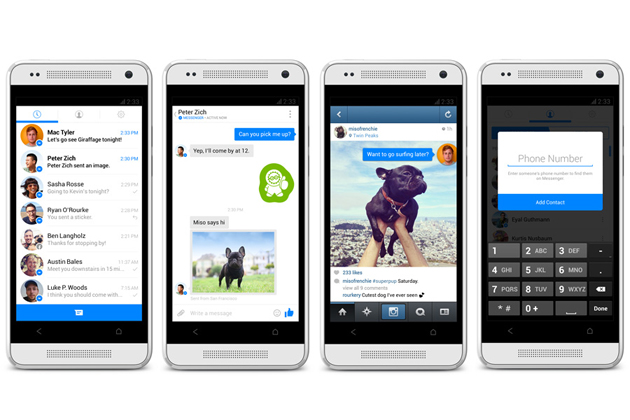
This rapid-fire approach can be seen in bigger changes as well. Projects like the@facebook.com email service, Poke, Places, Deals and Camera have all struggled to gain traction and many were eventually shuttered. For all the failures, however, introductions like Graph Search and Messenger have proven to have lasting significance and usefulness. With a growing interest in reader-style apps like Flipboard, Google Newsstand and Feedly, Facebook unveiled its Paper app in January. Citing the need for a "distraction-free" reading experience, the company inserted itself in an area it felt needed improving, and sought to do so with better design. It's too early to tell if this pet project will pay off and it's currently only available for the iOS faithful.
THE NEXT BIG THINGS
While declining traffic amongst teens may be a growing concern, Facebook's track record shows it's willing to rejigger its offerings to cater to what users want, even if that means spending some cash. The company nabbed up Instagram in April of 2012 for $1 billion, adding a loyal base of users concerned with sharing even the smallest details of everyday life. In response to Snapchat's rising popularity and a reported failure to buy that particular service, Instagram Direct added photo swapping between users outside of the regular snapshot timeline in late 2013.
Investing heavily in design and letting form follow function, with a little shopping thrown in, is still paying huge dividends 10 years in.
Global efforts ramped up last month with the whopping $19 billion WhatsApp acquisition, locking down its several hundred million users and proven success in free messaging and upcoming voice features -- an area that's been of interest to the social network for quite some time. When expanding its reach and increasing shared content, Facebook's moves show that sometimes design isn't enough, and expanding by buying up the competition's unique feature set is another avenue for growth. It's even banking on virtual reality as the next big thing for not only gaming, but also for communication as a whole by snatching up Oculus.
With all of the successes, questionable moves and an increasingly mobile mindset, Facebook is still the largest social network on the web and tallies 1.23 billion monthly active users, far exceeding its closest rival, Twitter, which counts 241 million users per month. Investing heavily in design and letting form follow function, with a little shopping thrown in, is still paying huge dividends 10 years in.
To celebrate our 10th anniversary, we'll bring you a new story every week in March that explores how the social media landscape has changed. Check out our hub every Wednesday for more from of our 10 Years in Social Media series, and keep your eyes out for more '10 Years In' content in the months to come.
Friday, 28 March 2014
Facebook To Use Drones, Satellites and Lasers To Deliver Internet Around the World
Facebook's next big ambitious project is to make Internet accessible to everyone around the world. To make it happen, Facebook CEO Mark Zuckerberg has announced that they will use drones, satellites and lasers.
On Thursday, March 27, Zuckerberg posted a status on Facebook, sharing some updates about the frontier and giving a few hints on their future plans to reach the goal.
"We've made good progress so far. Over the past year, our work in the Philippines and
Zuckerberg said that Facebook will continue their partnership with the operators in the two countries, but claimed that the online social networking service will need new technology to reach other parts of the world, and that is currently what Facebook's Connectivity Lab is working on.
At the latter part of the post, Zuckerberg revealed that Facebook is currently collaborating with NASA's Jet Propulsion Lab and Ames Research Center for the grand initiative, and announced that the team has just gotten bigger now that they are also working with a small UK-based company Ascenta for a connectivity aircraft. Founders of the said company were the one's responsible for the early versions of Zephyr, the longest flying solar-powered unmanned aircraft in the world.
According to a press release published on Internet.org, two thirds of the world's population doesn't still have access to Internet, and in order to connect them to the world, the team is currently developing new delivery platforms.
"The team's approach is based on the principle that different sized communities need different solutions and they are already working on new delivery platforms-including planes and satellites-to provide connectivity for communities with different population densities," the press release detailed.
Friday, 21 March 2014
How Facebook and Google are changing the future of Intel’s CPUs

There’s a transformation in CPU design taking place just below the surface of the market. In the long run, it could prove every bit as important as the shift from single-core to multi-core processors, or the transformation of the x86 architecture from a me-too product for personal PCs into a market-spanning titan. Intel’s CPUs aren’t just being designed by Intel anymore. Companies like Google, Facebook, and Amazon are now playing a direct role in hardware design.
To understand the significance of this change, we need to revisit how CPU design has evolved over the past few decades.
In the mid-1980s, Intel rapidly devoured the desktop market. In the mid-1990s, it ate the datacenter. Obviously these market gains were driven by close customer partnerships, but the late 1990s saw the debut of RDRAM, Itanium, and the P4 (Netburst) architecture — technologies arguably designed to benefit Intel’s bottom line far more than the customers that purchased them.
Competition from AMD, concerted pushback from the DRAM industry, and the failure of Dennard scaling sank these initiatives and forced Intel to consider new alternatives in the form of multi-core products and what we’ve previously called “More than Moore” scaling. More-than-Moore (MtM) is defined by the ITRS (International Technology Roadmap for Semiconductors) as addressing “an emerging category of devices that incorporate functionalities that do not necessarily scale according to Moore’s Law, but provide additional value to the end customer in different ways.”
Working with major datacenter partners is becoming a critical way to find and identify new opportunities that go beyond simply scaling parts to lower power consumptions and hitting higher performance targets. It’s not that HP, Dell, and IBM are no longer important to the server business, but rather that Facebook, Amazon, and Google now do huge business volumes as direct customers with custom projects and specific needs.
The exact degree of customization that Intel does for these companies is still unclear. It’s easy to imagine Intel offering high-clock SKUs with correspondingly higher TDPs, or working to develop low-power products, but a recent report indicates that the collaborationgoes much deeper. According to Frank Frankovsky, head designer of hardware for Facebook, the company works with Intel quite closely.
“The more insight we can give our technology suppliers about what makes our software work the best, the more we’re able to influence their design roadmaps,” Frankovsky says. “We do influence their roadmaps — way upstream — but then they are able to bring these changes out to all of their customers.”
This could be seen as an outgrowth of the “dark silicon” phenomenon. One of the problems with the phrase “Moore’s law” is that it’s historically been used in two very different ways. The original version of Moore’s law states that transistor density doubles every 18-24 months. Later, this was expanded to include the phenomenon known as Dennard scaling. Dennard scaling was the observation that as transistors got smaller, the power used by each transistor shrank.
Moore’s law — the increasing density of transistors over time — still holds true. Dennard scaling doesn’t. As a result, it’s increasingly difficult to turn all the transistors in a CPU on at the same time while remaining within a given thermal envelope. This is a problem that’s only getting worse over time. There’s no single solution at this point, but low-density specialized silicon for implementing certain capabilities in hardware is one method of addressing the problem. Intel’s NTV (Near Threshold Voltage) research and the shift towards heterogeneous computing are both approaches that focus on utilizing dark or dim silicon to improve performance without sabotaging power consumption.
AMD has said it also handles some semi-custom work, but I’m betting the company’s hands are generally full of PS4, Xbox, and Wii U-related work at this juncture. TSMC and GlobalFoundries will happily build Facebook a custom core, but don’t maintain full design houses to create such a product from scratch. For now, this is a fairly potent Intel advantage. Looking at the list of new features in Intel’s 22nm Atom, it’s impossible to tell which ones are the result of close collaboration with Intel’s new partners, but we’d bet at least a few of them are.
Facebook’s comments imply that while it’s working with Intel to implement new capabilities, not all the features are explicitly exclusive. Intel, in other words, might have added AES-NI instructions to Atom because certain customers wanted those capabilities, but it’s scarcely hiding the fact. For now, none of the companies involved want to give specifics. Once you understand the problem, the idea of Intel doing custom work for a new type of customer makes far more sense.
The standard server OEMs still have an important role to play in distributing general computing hardware, but for Intel, working with Facebook, Google, or Amazon gives the company long-term visibility into its customers’ needs. It also helps reduce the chance of a sudden ARM coup. While we haven’t seen the text of any agreement between Intel and these new customers, it’s safe to assume that the major companies are contributing to the customization work and have committed to using the final product.
Facebook is working on ‘deep learning’ neural networks to learn even more about your personal life

Facebook is beginning to take a new approach to the task of digitizing our personalities and spinning them into nicely saleable little packages. After all, posting and updating an exhaustive list of your favorite bands tends to lose its appeal around the end of adolescence; if Facebook wants to truly understand our material wants and needs, it will have to look into our much more personal, much less intelligible communications. This week, Facebook’s chief technology officer said the company’s newly formed AI team has its sights set on building neural networks to learn about your personality in a new and remarkably human way.
Artificial neural networks mirror biological ones, using nodes rather than neurons but building the same sorts of complex interconnections between them. Rather than storing all data in a huge pool to be analyzed as a whole, neural networks remember associations between concepts, streamlining the process of retrieval and analysis. They allow computer scientists to make algorithms for something called “deep learning,” which arranges ideas as layers of definitions. Small concepts collectively define larger ones, which define larger ones, and so on. With enough input information, a sufficiently detailed neural network can learn quite deeply indeed — and, with the possible exception of Google, nobody has access to more raw information than Facebook.
The primary goal of all this is supposedly to improve the venerable News Feed, but when it comes to Facebook the primary goal is always ad sales. Still, powerful deep learning algorithms have the potential to change most of how we interact with social media. What if Facebook or Twitter could recommend a slight rewording to your latest update — switch the word “CPU” for “processor” and get an average 2.4% more attention! What if an algorithm could tell you which cover image will get your photo album the most interest, or search your images for only happy situations? (The “find bikini pics” option will likely be third party, but quick to appear.)
This isn’t all speculation, either. Google famously taught a neural network torecognize human faces, and Microsoft is using them to bring speech recognition and translation into real time. This all requires that the network make sense of uncategorized information — in other words, it has to be able to turn an arcane posting like “i <3 u babe” into a series of machine learning events, from an increase in babe’s visibility on your News Feed to an automatic alert should the babe in question change their relationship status. Discussing podcasts with a buddy should flag you as a fan of not just the specific shows you mention, but of the medium as a whole, and add to the probability that you also like, say, video games. Deep learning is about making data analysis sophisticated enough to derive your personality from your natural social output.
The AI team tasked with achieving those sorts of gains only recently began this effort, but it brings together experts from all over the field. Yaniv Taigman was the cofounder of facial recognition company Face.com and now works with the team alongside academics like Marc’Aurelio Ranzato and Facebook old-timers like Keith Adams. Though other companies have a head-start, the sheer breadth of information available to Facebook gives its efforts some uniquely personal implications.
Myself, I don’t mind if Facebook peeks in on my activity, just a bit. If we take it as given that social media will be ad-driven for the foreseeable future, we might as well try to make sure those ads remain relevant to our interests. If a banner ad can alert me to a great sale on my impending purchase, or a local tour date for my favorite band, advertising can actually enhance the usefulness of the site as a whole. Sometimes we’re nice enough to place that sort of information in an easily analyzed form — I put Star Trek on my list of favorite TV shows, and an algorithm shows me an ad for Into Darkness. It’s a fairly straightforward process and (leaving aside any possible leakage to government overseers) one that should not overly bother most users.
Facebook acquires WhatsApp for $19 billion, in desperate attempt to stave off stagnation

Late yesterday, Facebook acquired WhatsApp for the princely (and ludicrous) sum of $19 billion in cash and stock. This is one of the largest acquisitions in Silicon Valley history — and yet, if you’re American, you probably don’t even know what WhatsApp is, let alone why it’s worth $19 billion. In a sentence, WhatsApp replaces text messaging (SMS) — and it has grown to 450 million monthly users in under five years. While a purchase price of $19 billion might seem like insanity, especially when compared to its $1 billion acquisition of Instagram, it’s actually a savvy (or desperate, depending on your point of view) move to ensure that Facebook remains the world’s predominant messaging platform.
What is WhatsApp?
The short answer is that WhatsApp is a replacement for SMS (texting) for every major mobile platform (iOS, Android, Symbian, Windows Phone, BlackBerry) — but it also allows you to send photos, videos, and audio clips as well. Because it uses the internet, and thus your data package, it avoids the crazy fees that some carriers charge for SMS. WhatsApp has done for instant messaging what Skype did for international calling, basically.
Why haven’t you heard of WhatsApp? Because, for whatever reason, it hasn’t yet become popular in the US. It is incredibly popular in the rest of the world, though — most notably in Europe, but also in the all-important developing economies of Africa and Asia. The growth rate of WhatsApp has been utterly insane: In November 2013 it had 190 million monthly active users; today, it has 450 million active users and 320 million daily active users, with 1 million new users joining every day. Upwards of 50 billion text messages are sent and received by WhatsApp every 24 hours (more than doubling Facebook’s usage), along with hundreds of millions of photos and video messages. WhatsApp is huge.
In terms of monetization, WhatsApp is free for the first year, and then $1 per year after that. There is no advertising. The entire service is developed and maintained by less than 50 employees. The company has never spent a penny on marketing. WhatsApp is a classic example of identifying a gap in the market, and then producing a very simple app that perfectly fulfils that need. (The back-end — which is probably one of the busiest databases in the world — is programmed in Erlang, incidentally.)
Why did Facebook pay $19 billion for WhatsApp?
Depending on how cynical you are, there are a few answers to this question. The most likely answer is, Facebook is terrified of losing its position as the world’s primary social network and messaging platform. Instagram threatened Facebook’s role as the best place to share photos, and Facebook scooped it up. WhatsApp, which already dwarfs Twitter, Skype, and Facebook Messenger in terms of users and usage, was probably keeping Zuckerberg up at night — thus the acquisition. ”WhatsApp is the only app we’ve ever seen with higher engagement than Facebook itself,” Zuckerberg said during a conference call yesterday.
Another possibility is that Facebook simply sees WhatsApp as an easy way to pick up its “next billion” users. Facebook, which sits at around 1.23 billion monthly active users, has previously stated that the only way it will keep growing is if it taps developing markets in Asia and Africa. WhatsApp is already huge in both those areas. It’s also worth pointing out that Facebook now has access to a lot of mobile phone numbers, and a lot of new advertising eyeballs — though, for now, Facebook says WhatsApp will remain as-is, just like Instagram. (Read: Facebook, ARM, x86, and the future of the data center.)
At the end of the day, though, spending $19 billion — more than 10% of Facebook’s total market valuation — without a clear purpose in mind is a big pill to swallow for Facebook’s share holders. (Incidentally, Google reportedly offered $10 billion for WhatsApp, but was turned down.) Having said that, considering carriers squeeze billions of dollars per year from SMS, maybe $19 billion is actually a small price to pay for a big slice of that pie — maybe this is actually a sign that Facebook is diversifying, in case the bottom falls out of the advertising market.
Ultimately, Facebook is paying a lot of money to make sure that the bulk of the world’s communications continue to flow through its network. What the company’s end game is, though, no one really knows. Putting so much information in the hands of a commercial company makes me a little bit nervous.
Facebook eyes up solar-powered drones, to blanket the world with internet access

Facebook, with the thinly veiled veneer of “bringing internet access to the underconnected,” is looking to acquire Titan Aerospace — an American maker of high-altitude UAVs (drones). The idea is that these Titan drones would be used to connect the 5 billion or so people who don’t yet have reliable internet access — a philanthropic act on the face of it, but when you consider that Facebook’s entire business model is predicated on continued growth, and that almost everyone in the world with an internet connection already has a Facebook account, you can see that this is more about self-preservation than humanitarianism.
Titan Aerospace has two products, the Solara 50 and Solara 60, which the company refers to as “atmospheric satellites.” They seem to be functionally identical, except the Solara 60 can carry a larger payload. Both aircraft are powered by a large number of solar cells, allowing them to ascend to 65,000 feet (almost 20 kilometers), and then circle over a specific region for up to five years (presumably that’s the lifetime of the on-board lithium-ion batteries, which are required for night-time operation). The high altitude is important: The FAA only regulates airspace up to 60,000 feet — above that, pretty much anything goes.Once these atmospheric satellites are up there, there’s a wide range of possible applications. Facebook is obviously interested in internet connectivity, but mapping, meteorology, global positioning, rapid response to disasters and wildfires, and a whole slew of other scientific and military applications are also possible. (Read: Facebook creates Internet.org alliance to reduce price of mobile data plans to 1% of current price.)
As for what level of connectivity Facebook hopes to provide with these drones, it’s too early to say. TechCrunch reports that Facebook, which is looking to acquire Titan for $60 million, would launch 11,000 Solara 60 drones. Their coverage would begin with Africa, and then spread out from there. There’s no word on how fast these connections might be, nor how much such a connection would cost the end user. Perhaps more importantly, there’s also no word on how Facebook intends to connect these 11,000 satellites to the internet. Facebook will need to build a lot of ground stations, perhaps in very remote and very hard to administer areas, and then run fiber to hook them up to the internet. And yes, in case you were wondering, this effort appears to be very similar to Google’s Project Loon — which is essentially the same thing, but using big balloons instead of winged aircraft.
It’s worth pointing out that Titan hasn’t yet produced a commercial UAV. “Technology demonstrations” have been flown (probably much smaller prototypes), and “initial commercial operations” will start sometime in 2015. Perhaps this is why Facebook is only paying $60 million for Titan, rather than the $19 billion it paid for WhatsApp.
While bringing internet access to the underconnected masses is really quite a noble undertaking, don’t ever mistake this for an altruistic act. One of Facebook’s most pressing problems is how to grow its user base. Almost everyone who has an internet connection already has a Facebook account (or uses one of its national competitors, like Russia’s VKontakte). If Facebook doesn’t continue to grow, and doesn’t miraculously stumble across some way to make more money (its ads aren’t doing very well), the stock market will react very poorly indeed. Facebook is almost a victim of its own success — it got so big so quickly that it’s virtually impossible to continue the same growth trajectory. Acquiring Instagram and WhatsApp were a savvy moves to bring in a few hundred million more users, but ultimately they were nothing more than stopgap measures. Bringing the next billion users online and into Facebook’s gribbly mandibles will be a very hard task indeed.
Subscribe to:
Posts (Atom)
